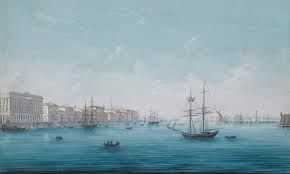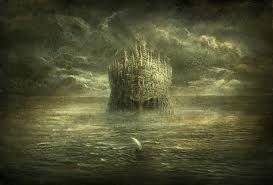In the ten years that I lived in London I went back and forth to Russia working with the new very rich on recreating the splendor of the past in their interiors, most of which looked to the revival styles of the 19th Century, rich with decoration and rarely classical. During this time I also starting following Contemporary Russian Art, which I found very different to the West, in particular the art coming out of St Petersburg. When I was hired by a Russian Contemporary Art Museum to market this art to the West, I explored what had happened in Russia following the Revolution in 1917 which had marked the end to the avant garde movement. The program after 1917 was for an art that upheld the principles of the Bolshevik Revolution.
Boris Kustodiev ‘The Bolshevik’ (1920), The Tretyakov Gallery, Moscow
Soviet Realism which came to be the State program was one of hyper- realism. Artists such as in order to convey an impression of the physical and martial prowess of its society. Soviet Realism happening through a great part of the 20th Century was both an alternative to contemporary art and a break with the past to create a new art while looking in the mirror of classic arts.
Aleksandr Denieka
For those artists who wanted to reference what had happened in Europe in the early 20th Century there was almost no opportunity to access the paintings of this period as they were removed from museum walls. It was only in the 1950’s that Matisse’s The Dance (1910) wa reinstalled in the Hermitage Museum. It was originally commissioned in 1910 by one of the leading Russian collectors of French late 19th and early 20th-century art, Sergey Shchukin. Until the Revolution of 1917, it had hung on the staircase of his Moscow mansion.
I took the art critic Ronald Jones with me to St Petersburg in 2011 to analyse Contemporary Russian Art emanating from this city. The older generation of artists spoke to us of what a profound effect The Dance had had on them and how many took jobs as cleaners or guards in the Hermitage in order to study the work. It gave impetus to an already existing movement of “non conformist art” which had in fact always continued underground since 1917, keeping the tenants of modernism alive.
Artists such as Oscar Rabin (b.1928), Oleg Tselkov (b.1934) and Vladimir Yankilevsky (b.1938). are among those who pursued their own artistic integrity under a hostile regime in USSR .
Oleg Tselkov
We found St. Petersburg to be a city dusted and faded, relics of its glorious past still beautiful and magnificent but the streets empty, cracks between walls, paint peeling, ,no high fashion boutiques – the rich having departed for Moscow to build a new city of glory each new oligarch wanting his diamonds or slice of cake as reflected in the work of Contemporary Moscow artist Serge Shutov from Moscow.
What we were to discover in St Petersburg was an artmaking very different to the West because artists had missed an entire century of discursion about the nature of art. Artists of the present in St Petersburg, look back at their own past, to icon making and to a culture of folkloric legend. They paint a reality of their own minds, which exist beyond the reality one can see.
In Russia reality has always been subject to ideological manipulation. It goes back to Icon Painting
This idea of a reality beyond the reality that exists – which may in fact be the true reality goes very far back in Russia’s history. It is a reality on which city of St Peterburg is founded. St Petersburg was from the beginning a glorious façade built on rotten soil – on a swamp not meant to support an Imperial City. It is the realization of a vision –the vision of its maker Peter I who saw beyond what was to something more real in his imagination.
“St. Petersburg, the most abstract and premeditated /umyshlennyi/ city in the whole world,” wrote Dostoevsky sensing that this was a city composed of fabrication lifted up from a reality of swamp and oil unfit for building to a vision that was grand and imperial
Dostoevsky wrote:
A hundred times, amidst this fog, I’ve been struck with a strange but importunate reverie: ‘And what if this fog were to scatter and leave for above, wouldn’t this entire rotten, slimy city take off with it, wouldn’t it rise up with the fog and disappear like smoke, and the prior Finnish swamp would remain, and, in the middle of it, for beauty, I think, the bronze horseman on his hotly breathing, exhausted horse?’
These photo/paintings by Contemporary St Petersburg artists Yaroslav Gerzhedovich illustrates this kind of visionary reality –totally different where the mind dares the viewer to go beyond a reality he knows to see what could be called “the edge of nightmare”.
This Is a contemporary statement of this reality of the mind. Something ominous and all encompassing is rising from the sea or swamp , a lone sailboat making its way towards it. This goulish appartition could be the reality of Russia after 1994 where the ruthless who grabbed opportunity made millions, where a new Russia came into being which for many was more restrictive than the one that existed previously, and which as it evolved created a present what for many was dangerous and foreboding.

Here one might say is a statement of how an ill wind, mindless and powerful is blowing across Russia which the single lone man tries helplessly to escape.
The bold Russian tradition of poking fun at political leaders extends to the country’s contemporary artists, who use both humour and controversy to express their discontent with the political system.
Viktor Kuznetsov
]
Andrey Zakirzyanov Is another artist who uses allegory to express dissatisfaction with a new regime that has marched through Russia, overturning its traditional values .
Russia is a country rich in folkloric legends because of the thousands of people who have crossed its soil leaving behind a legacy of other worldly places and narratives of imaginary places and people. One finds also charming whimsical creations of childlike fantasies inhabited by playful souls. It was these kind of legends that for centuries sustained peasants subject to harsh living conditions, poverty and long cold winters.
Nikolay Stoev
As we explored the city we found artmaking to be diverse – a new generation – emerging with high training from long established institutions each intent on looking into themselves, their present environment, and their heritage, and not at the world outside or the current international discourse going on in the West.








